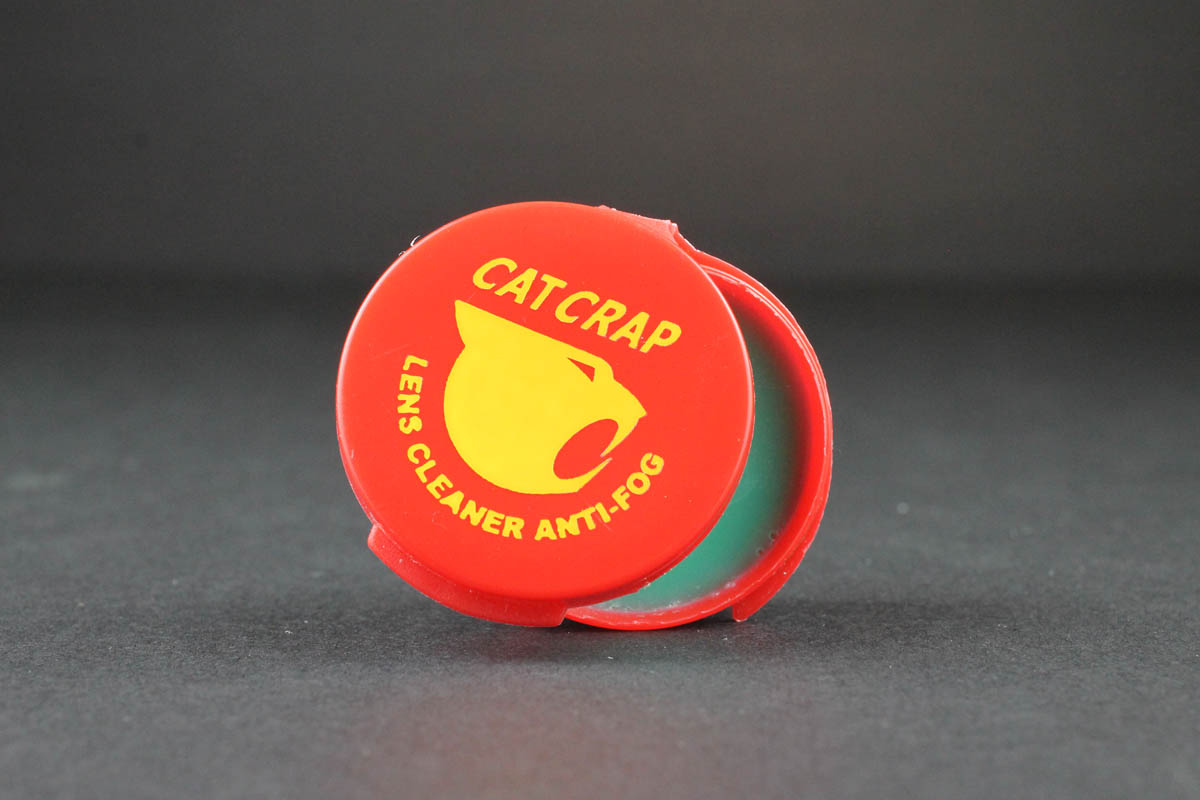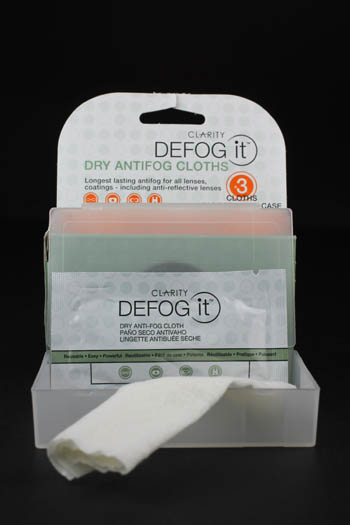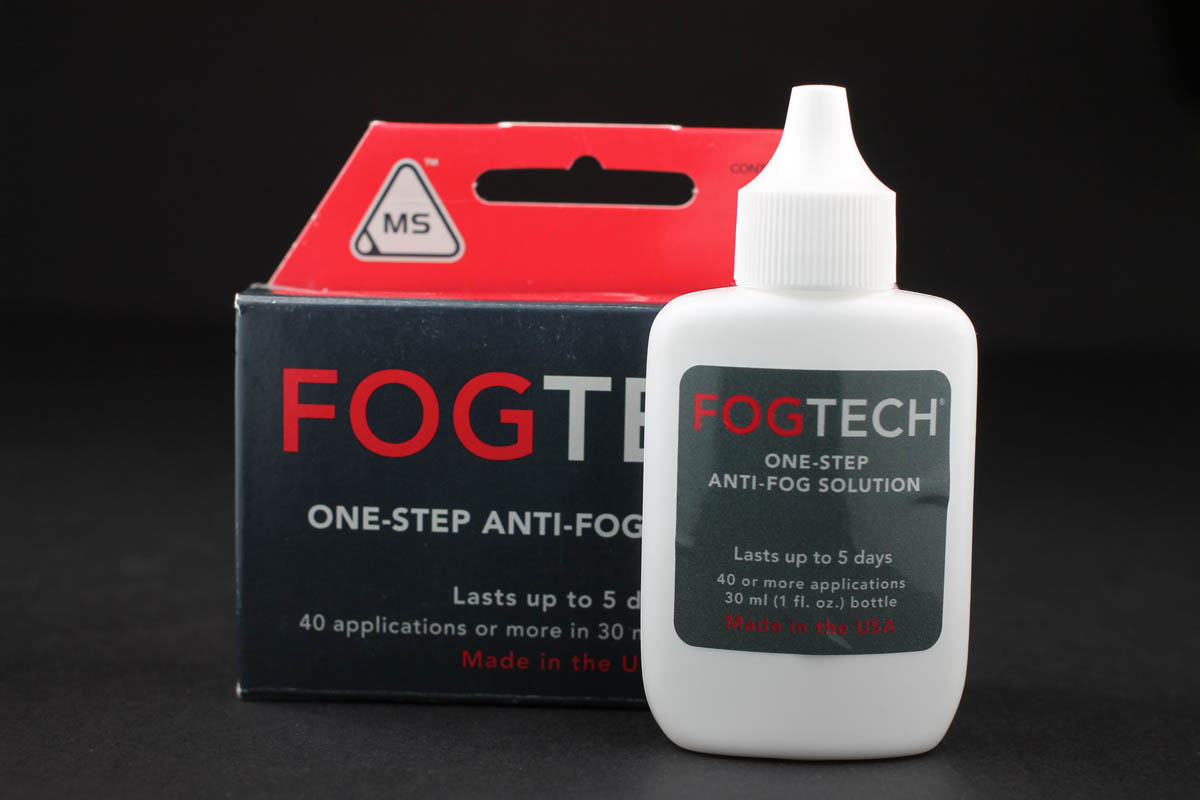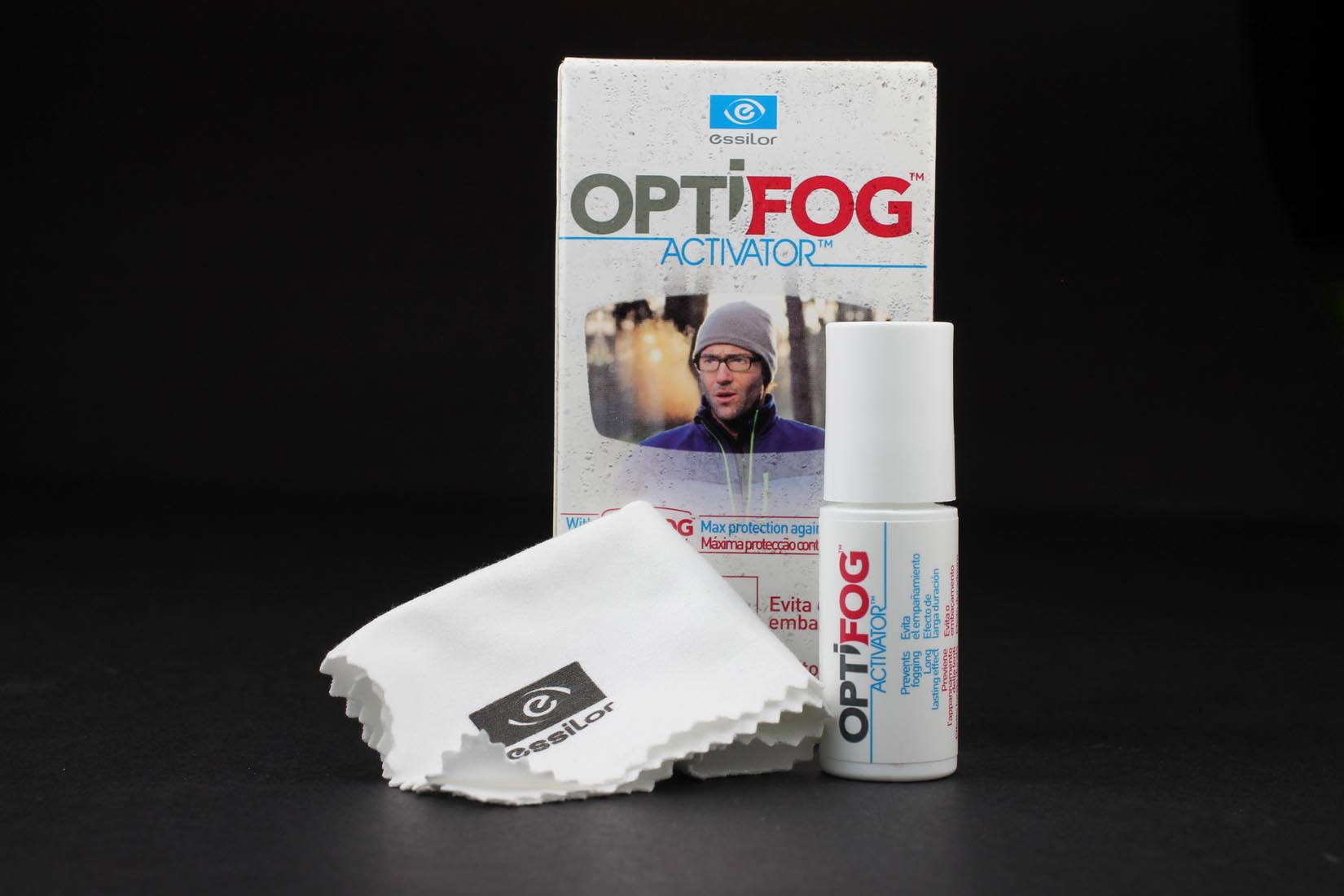It’s winter—or at least what passes for winter here in the San Francisco Bay Area—and it’s chilly, foggy, and occasionally rainy. If you’re a year-round rider like me, you’ve probably done your share of swearing inside your helmet because of a fogged faceshield or glasses.
It turns out the problem of faceshield fogging is pretty easy to solve: there are inserts that do a great job, or you can just pop the thing open and let some air in, as long as it’s not raining. Opening the faceshield can also keep your glasses from fogging—as long as you’re cool with being cold—but as soon as it starts raining, everything falls apart. If you open your shield to keep your glasses from fogging, rain runs down the inside of your shield and all over your glasses, and within minutes you can’t see a damn thing.
After enduring a near-blind, pitch-black night ride up Highway 1 from Morro Bay in pouring rain a while back, I vowed to solve this problem. So after disappointing results from the anti-fog home remedy of dish soap on my glasses, I went out and bought a bunch of anti-fog products.
I’ve been testing four products for the last few months, in everything from dry weather to fog and rain: Cat Crap, Clarity Defog It, MotoSolutions FogTech and finally, OptiFog prescription anti-fog lenses. The good news is, these products actually work pretty well—but not perfectly.
These all work in the same basic way—by adding a thin film on your lenses that keeps water in the air from condensing into tiny droplets, or fog. You can see this layer in action by applying one of these products and then holding your glasses over a steaming cup of tea. After a bit, if you look closely, you’ll see a transparent, almost oily-looking layer on the lens surfaces. This is what happens instead of fogging.
The downside of this layer is that it can cause some haziness. It’s generally not a big deal, but if you’re riding in extreme conditions it can become a problem. These products also tend to exaggerate ‘haloing’ around lights when riding at night. In both cases, it’s not as bad as badly fogged glasses—but still less than awesome.
Cat Crap
Cat Crap is one of the original anti-fog products—it’s been hanging around the litter box for a while. It also has the best name of the bunch: “Hang on, fellas. I gotta put some Cat Crap on my glasses before we head out.”
Application (crapplication?) is a two-step process. You rub a bit of crap on your lenses with your finger, and then buff it out. It took me a couple tries to get it just right—at first there was way too much haziness. Once I figured out the right amount of buffing, resistance to fogging was pretty good—but Cat Crap still suffers from the most haziness and haloing of the three general-use products I tried. I also found it needed to be re-applied frequently, generally every day or so.
|
Effectiveness |
Longevity |
Haziness |
Ease of Use |
Price |
Overall Rating |
|
★★★★ |
★★★ |
★★ |
★★★★ |
★★★★★ |
(3.6) |
You pay: under $10
You get: ½ ounce of crap
This stuff is: paste
Other options: spray
Clarity Defog It
Clarity’s Defog It anti-fog cloths are a cool idea: a reusable cloth that you wipe down your lenses with as needed, much like you would clean your glasses with a lint-free cloth.
Application is easy—simply wipe down your lenses for 10-15 seconds. After use, you’re supposed to stow the cloth in the included cases to keep it clean for reuse, but unfortunately, the cloths seem to dry out pretty quickly—meaning the three cloths really don’t last that long.
Performance is tops, though—as good as any of the products I tried, with less haziness than Cat Crap or the OptiFog lenses. They’re also very easy to use. Although Defog It needs to be reapplied frequently (as do all of these products), the only thing keeping these from being my go-to anti-fog product is the fact that the cloths dry out quickly—effectively increasing the cost per use quite a bit.
|
Effectiveness |
Longevity |
Haziness |
Ease of Use |
Price |
Overall Rating |
|
★★★★ |
★★★ |
★★★★ |
★★★★★ |
★★★ |
(3.8) |
You pay: $10-$15
You get: 3 reusable Defog It cloths in a plastic case
This stuff is: little “dry” wipes
Other options: liquid
MotoSolutions FogTech
FogTech is the best of the bunch: easy to use, effective and reasonably long-lasting. Application is also among the fastest: squirt a bit of solution on one of the included applicator cloths and quickly paint a thin layer on your lenses. No buffing! The solution dries quickly and is essentially unnoticeable.
I tried FogTech on a pair of glasses with an anti-reflective coating first, and it was way too hazy. I emailed MotoSolutions to see what they said, and the owner responded to my email within 15 minutes, saying that the solution doesn’t work on some anti-reflective lenses and that I could send my bottle back for a full refund. We exchanged a couple of emails and the level of customer service and attention for an under- $20 product impressed me. Needless to say, I didn’t return it, but rather used it on a pair of glasses with no anti-glare coating.
Performance is very good—on par with Clarity’s Defog It, but you get a lot more applications per bottle. As with the others, the product has to be reapplied a lot more than the manufacturer indicates, but clarity is good, with limited haziness and haloing. As a result, FogTech is currently my go-to anti-fog for daily use.
|
Effectiveness |
Longevity |
Haziness |
Ease of Use |
Price |
Overall Rating |
|
★★★★ |
★★★ |
★★★★ |
★★★★★ |
★★★★ |
★★★★ |
You pay: $10-$20
You get: 1 ounce bottle of FogTech and three tiny applicator cloths
This stuff is: liquid
Other options: wipes—even camo!
OptiFog Prescription Lenses and Activator
Since what I really wanted was for my glasses to be as awesomely fog-free as the Pinlock faceshield on my helmet, I decide to spring for a pair of anti-fog prescription lenses. These things aren’t cheap, and while your vision plan may entitle you to a discount, it’s not likely to cover the lenses. So they better be good, right?
Wrong. After dropping a significant chunk of cash on these fancy anti-fog specs, I was bummed to find that I’d still have to use an “activator” to make the magic happen, making my expensive anti-fog glasses no more convenient than pretty much any old pair of glasses and a bottle of FogTech. Even worse, the lenses are very susceptible to scratches and got pretty thrashed in short order—not exactly the golden ticket for a sport like motorcycling.
Prepping the lenses is much like applying FogTech. Squirt a few drops on a lint-free cloth and wipe it on—no buffing. If the performance of the lenses was amazing, I might be able to convince myself that the high price and generally crappy experience was worth it, but the OptiFog lenses are no better than any of the other anti-fog solutions I tried. While resistance to fogging is close to FogTech and Defog It, these lenses have a high level of haloing and haziness, and still require reapplication of the activator every couple days (Editor’s note: Opti-Fog claims the activator should be good for a week, and a 5 ml bottle–$10—should last about 6 months).
|
Effectiveness |
Longevity |
Haziness |
Ease of Use |
Price |
Overall Rating |
|
★★★★ |
★★★ |
★★ |
★★★★ |
★ |
(2.8) |
You pay: depends—frames and lenses are likely to set you back $200-$300 or more. Your vision plan may help—but don’t count on it.
You get: another pair of prescription glasses, a tiny (.17 ounce) bottle of Activator and a lint-free cloth.
This stuff is: prescription lenses and a liquid activator.
Other options: you can pick whatever glasses you want, but the lenses and activator remain the same.
Product Comparison
Here’s how these products stack up against each other:
|
Effectiveness |
Longevity |
Haziness |
Ease of Use |
Price |
Overall Rating |
|
| Cat Crap |
★★★★ |
★★★ |
★★ |
★★★★ |
★★★★★ |
(3.6) |
| Clarity Defog It |
★★★★ |
★★★ |
★★★★ |
★★★★★ |
★★★ |
(3.8) |
| MotoSolutions FogTech |
★★★★ |
★★★ |
★★★★ |
★★★★★ |
★★★★ |
★★★★ |
| OptiFog Lenses+Activator |
★★★★ |
★★★ |
★★ |
★★★★ |
★ |
(2.8) |
My Way (On the Highway)
It’s possible to achieve effective anti-fogging performance on glasses inside a full-face helmet, but unlike faceshield inserts, which are largely a “do it and be done with it” affair, keeping your glasses from fogging requires frequent reapplication of the product. In extreme conditions, it may be necessary to reapply more than once a day, although an average commuter should be able to get a couple of days per application out of most of these products.
My current anti-fog system consists of a Pinlock shield and a pair of glasses I reserve for riding. I chose Transitions lenses with no anti-reflective coating, so I could ride with the same glasses day or night. I generally apply MotoSolutions FogTech every day or two. With this setup, I can ride with my shield completely closed, with no fogging of my glasses and good visibility in rainy weather.











Fog-free glasses and face shields… always a PITA. The glasses I have tried were out and out crap, totally worthless.
I have tried many different antifog products with the same results as above. All increase the haloing and increase the cleaning frequency required and require very often reapplication.
The pinlock shields seem to be good for their anti-fog capabilities but suck at everything else: 2-3X the effort to clean, 2X layers of non-optically clear plastic to look through and all the haloing, surface flaws and other such negative effects. No thanks! Whoever came up with the idea needs to be flogged.
What I have found works best, is to just clean the face shield and glasses at least once a day using a microfiber towel or a t-shirt or a handkerchief and windex or any other suitable window/glass cleaner. Clean lenses seem to fog less.
Rain-X seems to be the best “treatment” on the market but is not very effective at anti-fog but does seem to be better than nothing. I usually use Rain-X on my face shield before heading out on a multiday trip.
Thanks everybody for the positive and helpful comments!
My solution to the whole fog-thing is a Foggy Respro (or is it the other way round?) neoprene mask. That way, I don’t have to look through a poor (in my view) pinlock film or apply gloop to my Zeiss specs lenses. The small amount of fogging that may still occur takes very little extra ventilation to clear it. The fit of the mask is critical to prevent breath going behind my specs, it won’t flip a flip-front helmet at all easily and the neoprene doesn’t last for ever but its by far the best solution for me.
Nick, UK
Sorry, I mean’t it won’t FIT a flip-front helmet…
Nick
I’m not familiar with that brand; however I have tried 3 different, uh, neoprene densities. The sturdiest being the airsoft kind of mask: that’s too stiff and won’t adhere correctly to your face; the medium and soft ones are ok for me, but they all require a flip front helmet. You can use them under an intergral one, but it’s a pain to adjust them properly once worn the helmet…
Anyway the softest model is enough for a decent protection. I noticed that the sunvisor is an effective protection against direct air, allowing you to keep the lid open those few millimeters useful for defogging; unfortunately that can be done with enough light, only. Manufacturers could think of yellow replacements for the winter…
I found the use of a neoprene mask, snowboarders’ style, much more effective than motorcycle-specific balaclavas. With nose shaped air vents, it helps reduce glass fogging, and, being more adherent to your face, keeps warmer, too!
Thanks for the test. its great to see a side by side comparison. I’ll stick with my Fog tech as it works well and they have been good to me.
when my windshield fogs, I just turn my climate control over to defrost. wait… what…?
My old Schuberth helmet had a faceshield mechanism that had an additional position that would allow the shield to click straight forward about 1/8″. So you could have the shield all the way closed, but crack the right side (or left side, or both) forward just a bit so the shield did not seal on the rubber. It let in just the right amount of air on cold days, but a rainy day would let some rain in as well.
I have tried using a small piece of wire, plastic, etc. to wedge on the bottom edge of the faceshield of my new helmet. Just a bit of tape to keep it in place on the chin bar to keep the bottom from sealing, but the top edge still sealed, or mostly sealed. Does not look slick, but works better than without it.
Nice review article. Something I don’t have to worry about at the moment as I’m in sunny AU, but this is a topic that never gets mentioned by the general motorcycle press. I try to keep it simple and just do the “crack the visor a bit” trick, and resign myself to fog being an inevitability in very cold riding. I found the wipe-on solutions like Fog City to be too much of a hassle to be a routine thing, especially with multicoated lenses.
Another trick I have found to work well (despite being counterintuitive) is to remove all breath guards and chin guards. There is less fogging with greater ventilation. Breath guards just seem to direct my breath directly into the glasses. The downside to this approach is a cold noggin.
If it’s really freezing or pouring with rain then I wuss out and drive the car.
Going open face with a scarf / windstopper mask is also a great solution, especially shorter rides.
So, your Transitions lenses work behind a face shield? Mine didn’t. The shield filters the UV light to which the lens reacts. That’s why you won’t get a sun burn through it either.
Nah, they don’t—or not really. If I open the shield they’ll start to darken up, and I’ll often ride at lower speeds with the shield open if the weather is nice—I like the air flow. I mostly went with the Transitions because it’s nice to have “sunglasses” when off the bike.
learn something new every day! Was wondering what was up with the lenses and now I know.
Thanks Jim
Riding in the winter around here is relegated to studded MX tires on the dirt bike for some snow riding. Brrrr. My favorite winter ride is the one I take inside my head while reading Peter Egan’s book Leanings.
If you’re caught in a bind use plain old dishwashing detergent. Just smear a small drop all over the glasses, wipe off excess carefully, then breathe on the lens to provide some moisture which will help blend the foggy detergent film over the lens. Used to do this skiing after I tried those expensive commercially available solutions.
What do divers use inside their googles? Spit (really), old cigarette butts (oil from the tobacco), soap or detergent, slice of potato.
Correction about scuba divers: We don’t wear googles and most of what you said sounds like an epesopde of seahunt. Today most divers use commercial anti fog goop.
Goose (PADI Rescue Diver and trained search and recovory diver)
Goose—what product do you use on your non-goggles? Love to try it.
Huladog—I actually tried both soap and spit, with very poor results. Maybe I was using the wrong soap?
Great information for us riders who wear glasses. Thanks for providing your testing data.
The liquid version of Clarity works very well.
Thanks for the comparo Surj. Not everyone takes the time or expense to test these things out. While reading I kept wondering if there are favored products used by skiers and snowboarders or even for diving masks that should be looked at?
I tried to supply info on this but for some reason my “comments awaiting moderation” apparently didn’t meet the requirements of the moderators? WTF???
Sometimes it takes a long time to be moderated ( speaking from experience although Ive never said anything even remotely out of line)…patience grasshopper
Huh, now they’re back. Cool…
MGN, I actually read a lot of skier/snowboard/swimmer reviews before choosing the products I started with. Many of the others had almost universally bad reviews and didn’t seem worth buying.
I too, have tried everything. The ONLY thing I have found that works is a heated shield made for snowmobilers. It actually has a heating element and keeps both the shield fog free and my glasses fog free.
Not everybody can wear contacts.
I used to live in SF and can report 2 things (here in dry CO, where winter riding doesn’t work entirely perfectly, it’s less of an issue): 1) Shoei could stand to improve the “open it a crack” visor mechanism – put the hold-open tab on BOTH sides and you’ve got it. 2) Cat Crap only works marginally, when it works at all. This goes not just for glasses but visors and ski goggles as well – I keep trying it because a container lasts forever, but I think I’ll be looking into the FogTech.
Cool product review, at any rate.
Oh I meant to include, on “…and you’ve got it” ” – but the main thing is if a helmet is designed to crack the visor JUST A BIT (and said setting will stay without snapping shut) it can do a wonderful job of eliminating glasses fog, without letting rain in.”
Maybe if you wore contacts this wouldn’t be a problem at all. 8^ )
Then he’d have fogged up contacts!